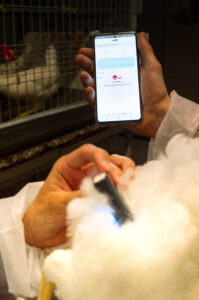Training sessions highlight how body-condition assessment can help sustain persistency and maximise egg numbers.
With demand for eggs increasing, the pressure is on the industry to increase productivity. “This will either be achieved by more birds, or more eggs per bird,” said Cargill technical application specialist Luke Barnard.
Speaking to producers and trade representatives at the Cargill poultry workshops this summer, he highlighted new technology that can provide a fast, non-invasive assessment of the body composition of the bird. With a proven correlation between body composition and layer persistency, this data can be used to pre-empt problems, keep birds on target and achieve efficient layer persistency with increased egg numbers per bird.
“It’s important to take a holistic approach to increasing egg production by taking advantage of breeding advances, good nutrition and management knowledge that encompasses the ‘ideal’ lighting, environment and health care,” he said.
“If we want birds to lay for longer and produce more eggs, we need to set them up for success,” he said. “This means investing more in the rearing period and getting the birds as robust as possible.”
Cargill has researched the impact of nutrition on laying persistency and compared diets with varying levels and combinations of dietary energy and oil content. Results found that egg number could be manipulated through the diet. Data also shows a lower rate of decline in egg numbers where energy was reduced but the oil content of the ration remained high.

“The diet will affect body composition, hormone pathways and liver function. All these factors impact egg production,” said Barnard, adding that hens with an optimal body condition score have been found to have an extended production cycle.
“We know body composition is a long-term predictor of laying persistency and that body composition at 20 weeks old correlates with egg production between weeks 63 and 75. So by measuring body composition we can fine-tune inputs, particularly diet, to improve long-term egg production.”
One indicator of body composition is weight of fat pad. “The two are strongly correlated, and an over-developed fat pad be detrimental to long-term egg production and optimal liver function,” added Barnard.
The new measurement tool Reveal Layers, developed by Cargill, uses a non-invasive handheld infrared monitor to scan the fat pads in rearers and layers. Results are logged directly via Bluetooth to a mobile device and results are assessed and benchmarked against the optimum body score range for their age.
Cargill has collated a large database to calibrate body condition against productivity relative to hen age and colour. It has used this and in-depth knowledge to develop accurate algorithms. This information allows for corrective measures to be taken when flock data deviates from the expectation.
“We recommend scanning fat pad weights in a random group of between 50 and 100 birds every four to six weeks,” he said. “Reveal Layers is recommended in flocks of brown or white birds between 15 and 75 weeks old.
“The data provides producers and nutritionists with immediate access to body composition assessments of their hens. And we compare the results with Cargill’s benchmarks and the flock’s data to suggest nutritional changes and management changes to support future performance,” added Barnard.
“These decisions are in real-time and help to support the flock’s long-term performance. The tool gives us a new window into the birds’ condition and potential performance and provides insights that were not previously obtainable.”
Barnard pointed out that while a strong correlation is found between fat pad weight and body composition and productivity, there is no strong correlation between body weight and body composition.
Cargill has shown a difference of 80g in fat pad weight among birds of the same body weight, and a range in body weights of 700g among birds with the same fat pad weight.
“Just because the birds look the same, their body composition and egg production potential may be very different,” he added.
“But by optimising body condition, the hen’s productive period can be extended and egg production increased, making older flocks more viable. We could see a potential gain of between 10 and 20 eggs per bird at the same age of cull or an extended laying period. This gives more eggs and a lower annual pullet replacement cost, which can result in significant economic and environmental benefits for producers.”


